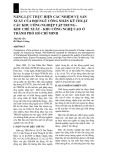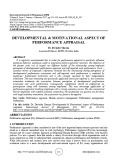
http://www.iaeme.com/IJM/index.asp 152 editor@iaeme.com
International Journal of Management (IJM)
Volume 8, Issue 1, January – February 2017, pp.152–159, Article ID: IJM_08_01_017
Available online at
http://www.iaeme.com/ijm/issues.asp?JType=IJM&VType=8&IType=1
Journal Impact Factor (2016): 8.1920 (Calculated by GISI) www.jifactor.com
ISSN Print: 0976-6502 and ISSN Online: 0976-6510
© IAEME Publication
DEVELOPMENTAL & MOTIVATIONAL ASPECT OF
PERFORMANCE APPRAISAL
Dr. Davinder Sharma
Associate Professor, BCIPS, Dwarka, India
ABSTRACT
It is regularly recommended that in order for performance appraisal to positively influence
employee behavior, employees ought to experience positive appraisal reactions. The objective of
the present study was to inspect two different models of the relationship among employee
perception of developmental performance appraisal and self-reported work performance. Cross –
sectional review of employee’s references revealed that the relationship among perceptions of
developmental performance assessment and self-reported work performance is mediated by
employees’ fundamental motivation and is also strongly reasoned by their independence
orientation. The most interesting and practically applicable conclusion reported is, how autonomy
orientation moderates the association between perception of developmental performance
assessment and work performance. Consequently, significance should be emphasized on
participation along with autonomy among employees. This may encourage application of
performance appraisal involving employees with a strong autonomy course. We also summarized
that for employees with a feeble autonomy orientation, the relationship was positive, but for those
with tough autonomy orientation, the association was found to be negative.
Key words: Performance appraisal, Human resource management, Performance management,
Orientation.
Cite this Article: Dr. Davinder Sharma, Developmental & Motivational Aspect of Performance
Appraisal. International Journal of Management, 8(1), 2017, pp. 152–159.
http://www.iaeme.com/IJM/issues.asp?JType=IJM&VType=8&IType=1
ABBREVIATIONS
Performance appraisal (PA), Balanced scorecard (BSC), Performance management systems (PMS).
1. INTRODUCTION
Performance Appraisal is often considered as one of the most important human resource practices and also
stands as a choicest researched topic in work psychology. Performance Appraisal (PA) has increasingly
become part of a more strategic approach in integrating Human Resource (HR) activities with business
policies. It is now a generic term that entails a variety of activities through which organizations seek to
assess employees in order to understand their competencies, enhance performances and distribute rewards.
While both practice and research have now moved away from a narrow focus on psychometric and
evaluation issues to a more developmental and motivational aspects of PA; many organizations still






























